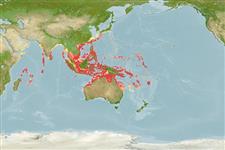Classification / Names
Common names from other countries
Main reference
Size / Weight / Age
Max length : 40.0 cm TL male/unsexed; (Ref. 55); common length : 35.0 cm TL male/unsexed; (Ref. 5450); max. reported age: 12 years (Ref. 37970)
Length at first maturity
Lm 15.4, range 14 - 22 cm
Environment
Marine; brackish; reef-associated; depth range 10 - 72 m (Ref. 9710)
Climate / Range
Tropical, preferred ?; 35°N - 26°S, 50°E - 180°E (Ref. 55)
Distribution
Indo-West Pacific: Seychelles, then southern India to New Caledonia and Gilbert Islands, extending northward to the Ryukyu Islands Replaced by Lutjanus ophuysenii from southeastern China and Taiwan to southern Korea and Japan (Ref. 37816).
Countries | FAO areas | Ecosystems | Occurrences | Introductions
Short description
Dorsal
spines
(total): 10;
Dorsal
soft rays
(total): 12-14;
Anal
spines: 3;
Anal
soft rays: 8 - 9. Dorsal profile of head moderately sloped. Preorbital width about equal to eye diameter. Preopercular notch and knob poorly developed. Scale rows on back rising obliquely above lateral line. Generally whitish or pink with a yellowish brown to black stripe on the middle of the side. Juveniles and sub-adults with an intensely black mid-lateral stripe and an oval black spot, eye-sized or greater, lying in the middle of the stripe below last dorsal spines. Adults with yellow median fins (Ref. 48635). Body depth 2.6-3.0 in SL (Ref. 90102).
IUCN Red List Status (Ref. 115185)
Threat to humans
Harmless
Human uses
Fisheries: commercial; aquarium: public aquariums
Tools
Special reports
Download XML
Internet sources
Estimates of some properties based on models
Phylogenetic diversity index
PD50 = 0.5000 many relatives (e.g. carps) 0.5 - 2.0 few relatives (e.g. lungfishes)
Trophic Level
4.0 ±0.3 se; Based on diet studies.
Resilience
Medium, minimum population doubling time 1.4 - 4.4 years (K=0.22-0.70; tmax=12)
Vulnerability
Moderate vulnerability (38 of 100)
Price category
